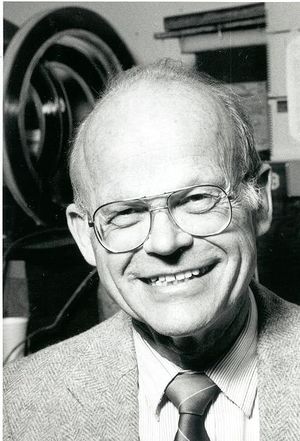Richard Stephen Muller: Difference between revisions
No edit summary |
No edit summary |
||
| (4 intermediate revisions by 2 users not shown) | |||
| Line 1: | Line 1: | ||
{{Biography | |||
|Image=Richard S. Muller 2486(2).jpg | |||
|Associated organizations=University of California | |||
|Fields of study=[[MEMS]] | |||
|Awards=[[IEEE Cledo Brunetti Award]] | |||
}} | |||
The individual and collective contributions of Richard S. Muller and [[Richard M. White|Richard M. White]] to the development and advancement of [[MEMS|micro-electro-mechanical systems (MEMS)]] have resulted in technologies critical to applications ranging from cell phones to air-bag sensors in automobiles. Dr. White’s development in 1965 of a microfabricated surface acoustic wave (SAW) electric filter is considered an early example of a MEMS device and the first to receive worldwide commercial attention. Today’s mobile phones rely on SAWs based on Dr. White’s work in order to function properly. Dr. Muller’s research in 1965 demonstrating mechanical coupling into microelectronic devices, and his further work on fabrication processes during the 1980s, were fundamental to the growth of MEMS. Dr. Muller and his research group introduced polysilicon as a structural mechanical material and pioneered “surface micromachining” for creating MEMS devices. In 1981, Dr. Muller successfully proposed to IEEE the creation of the Journal of Microelectromechanical Systems and served as its Editor-in-Chief from 1997 to 2012. Together, Drs. Muller and White in 1986 founded the Berkeley Sensor & Actuator Center (BSAC) with the support of the NSF at the University of California. Under the pair’s guidance, together with that of a subsequent growing number of BSAC Directors, this industry/university cooperative research center has educated generations of students, developing some of the premier researchers active today in the MEMS field. BSAC researchers have investigated and contributed in a broad area of MEMS advances, including those making possible the accelerometers and gyroscopes found in automobile safety systems. | The individual and collective contributions of Richard S. Muller and [[Richard M. White|Richard M. White]] to the development and advancement of [[MEMS|micro-electro-mechanical systems (MEMS)]] have resulted in technologies critical to applications ranging from cell phones to air-bag sensors in automobiles. Dr. White’s development in 1965 of a microfabricated surface acoustic wave (SAW) electric filter is considered an early example of a MEMS device and the first to receive worldwide commercial attention. Today’s mobile phones rely on SAWs based on Dr. White’s work in order to function properly. Dr. Muller’s research in 1965 demonstrating mechanical coupling into microelectronic devices, and his further work on fabrication processes during the 1980s, were fundamental to the growth of MEMS. Dr. Muller and his research group introduced polysilicon as a structural mechanical material and pioneered “surface micromachining” for creating MEMS devices. In 1981, Dr. Muller successfully proposed to IEEE the creation of the Journal of Microelectromechanical Systems and served as its Editor-in-Chief from 1997 to 2012. Together, Drs. Muller and White in 1986 founded the Berkeley Sensor & Actuator Center (BSAC) with the support of the NSF at the University of California. Under the pair’s guidance, together with that of a subsequent growing number of BSAC Directors, this industry/university cooperative research center has educated generations of students, developing some of the premier researchers active today in the MEMS field. BSAC researchers have investigated and contributed in a broad area of MEMS advances, including those making possible the accelerometers and gyroscopes found in automobile safety systems. | ||
| Line 9: | Line 11: | ||
{{DEFAULTSORT:Muller}} | {{DEFAULTSORT:Muller}} | ||
[[Category: | [[Category:Computing and electronics]] | ||
[[Category:Circuitry]] | [[Category:Circuitry]] | ||
[[Category:Microprocessors]] | [[Category:Microprocessors]] | ||
Latest revision as of 20:07, 24 February 2016
- Associated organizations
- University of California
- Fields of study
- MEMS
- Awards
- IEEE Cledo Brunetti Award
Biography
The individual and collective contributions of Richard S. Muller and Richard M. White to the development and advancement of micro-electro-mechanical systems (MEMS) have resulted in technologies critical to applications ranging from cell phones to air-bag sensors in automobiles. Dr. White’s development in 1965 of a microfabricated surface acoustic wave (SAW) electric filter is considered an early example of a MEMS device and the first to receive worldwide commercial attention. Today’s mobile phones rely on SAWs based on Dr. White’s work in order to function properly. Dr. Muller’s research in 1965 demonstrating mechanical coupling into microelectronic devices, and his further work on fabrication processes during the 1980s, were fundamental to the growth of MEMS. Dr. Muller and his research group introduced polysilicon as a structural mechanical material and pioneered “surface micromachining” for creating MEMS devices. In 1981, Dr. Muller successfully proposed to IEEE the creation of the Journal of Microelectromechanical Systems and served as its Editor-in-Chief from 1997 to 2012. Together, Drs. Muller and White in 1986 founded the Berkeley Sensor & Actuator Center (BSAC) with the support of the NSF at the University of California. Under the pair’s guidance, together with that of a subsequent growing number of BSAC Directors, this industry/university cooperative research center has educated generations of students, developing some of the premier researchers active today in the MEMS field. BSAC researchers have investigated and contributed in a broad area of MEMS advances, including those making possible the accelerometers and gyroscopes found in automobile safety systems.
Dr. Muller is an IEEE Life Fellow and member of the U.S. National Academy of Engineering. His many honors include the IEEE Cledo Brunetti Award (joint with R.T. Howe in 1998) and Third-Millennium Medal (2000). He is a Professor Emeritus and Professor in the Graduate School in the Department of Electrical Engineering and Computer Sciences at the University of California, Berkeley, CA, USA.
